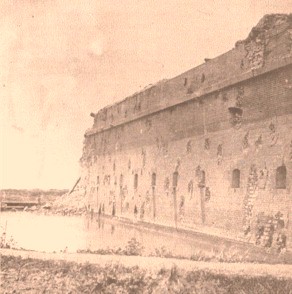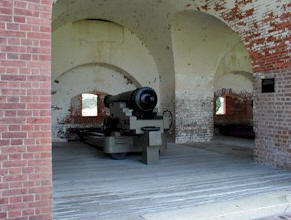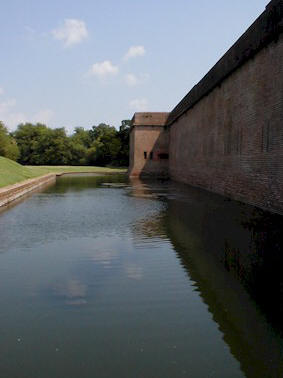Savannah Georgia is the home of the Fort Pulaski National
monument. Construction of this stately coastal fortification, built using more
than 25 million “Savanna Gray” and “Rose Red” bricks, was completed in 1847.
This valuable defensive position, which looks like a truncated hexagon,
consisted of a moat, parade ground and two powder magazines, would play a
critical role in the Civil War.
Early in the war, the Union Navy blockaded the Confederate
coastline in an attempt to cut all foreign trade and economic aid to the
South. Fort Pulaski protected Savannah’s prosperous seaport and the smugglers
who dared to run the Union guns to bring weapons, medicine and even liquor to
the beleaguered Southern army.
In 1861, Confederate militia under the command of Colonel
Charles H. Olmstead occupied Fort Pulaski, located on Cockspur Island. In the
spring of 1862, Federal troops under the command of General David Hunter,
landed on nearby Tybee Island unopposed by the Confederates who watched from
8000 yards away. Over the next two months, Union troops positioned 36 pieces
of heavy artillery on Tybee Island.
The resulting siege of Fort Pulaski would be the first real
successful test of the Union Armies new rifled cannon and would lead to the
eventual down fall of masonry fortifications in general. On April 10, 1862
General David Hunter began his bombardment of Ft. Pulaski. This artillery
barrage would continue non-stop until the afternoon of April the 11th.
Even though there had been no Confederate casualties,
Colonel Olmstead knew it would only be a matter of time before the Federal
troops breached the walls of the fort. Seeing no other option, Colonel
Olmstead surrendered Fort Pulaski to General Hunter later in the day. As the
captured Confederate soldiers marched out of Fort Pulaski, they probably felt
like they had let the citizens of Savanna down because they were supposed to
have protected them from the Federal Troops.
In 1864, 550 Confederate prisoners were held at Fort
Pulaski under the watchful eye of the Union troops garrisoned there. While
incarcerated at the fort, these heroes of the Confederacy, would endure
starvation, scurvy, and crippling dysentery. 537 prisoners would walk away
from their prison alive when they were transferred to Fort Deleware a year
later. The remaining 13 prisoners would die at Fort Pulaski, their bodies
ravaged by emaciation and dehydration.
There have been many ghostly sightings at Fort Pulaski over
the years. One particular encounter is relevant to our discussion because it
appears to have involved a very “commanding” interactive ghost.
In the late 1980’s, Savannah was again be occupied by both
Federal and Confederate troops. These Civil War reenactors were involved in
the filming of the movie “Glory”, which stared Morgan Freeman, Mathew
Broderick and Denzel Washington, and was shot on location at various locations
around Savannah. One group of re-enactors took advantage of some of their free
time, and visited Fort Pulaski while en route to the movie set. While these
modern day Civil War soldiers were exploring the fort, a young man wearing a
Confederate lieutenant’s uniform approached them. This young Confederate
officer began to reprimand the re-enactors for not saluting him upon his
approach. The lieutenant then ordered the re-enactors to fall into formation
because a Yankee attack was imminent.
The re-enactors wanted to put on a show for any other
visitors in the fort at the time, and decided to follow the lieutenant’s
commands. The lieutenant ordered the re-enactors to face about (turn away from
him), which they did without question. This was the last time they would ever
see the brash Confederate officer again. According the re-enactors, the young
man just disappeared and was never seen again.
Today, Fort Pulaski is a sacred National Monument. The park
is made up of over 5,623 acres of scenic Spanish moss draped marshes, yaupon
holly bushes and a vast array of wild life that help create the memorable
charm of the southern barrier islands.
Park Information:
Fort Pulaski National Monument:
P.O. Box 30757
Savannah, Georgia 31410
(912) 786-5787
© Copyright Dave Goodwin. All Rights Reserved.
Return to the Military Ghosts Home Page


